Why the Build Plate Matters

The build plate is arguably one of the most important parts of any 3D printer, as you can’t very well print without it. They come in many variations, with different surfaces, thermal characteristics, and price tags.
The primary function of a build plate is to provide a perfectly (or almost perfectly) flat surface for the bottom layer of your print. The second function is usually to provide an adhesive surface for the extruded plastic to form a temporary bond with during a print, or a surface onto which an adhesive can be applied.
In short, the build plate is a flat surface that printed objects will stick to during a print. Without this, your printer would need some sort of stasis field to hold a print in place while your printer fabricates objects in midair. As cool as that sounds, that sort of technology doesn’t exist yet (unfortunately), so we’re all stuck printing on glass and the like. That is, until our friends at BuildTak decide to develop such a field (hint, hint).
As there are many options for build plates, we’ve compiled a short list of the commonly used varieties and their unique properties. Please note that the majority of these solutions are intended to be installed on top of an aluminum (or similar) heated bed.
Printing on Glass
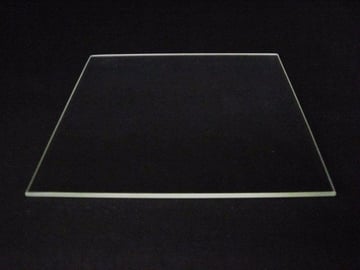
A glass sheet is likely the most popular, simple, and easy solution for a build plate currently in use today.
Glass is extremely stiff and (if made properly) flat, meaning that it shouldn’t warp over time, and will always provide a solid surface to print on. It’s also dense and has a low thermal conductivity, which means it takes longer to heat up but also spreads the heat more evenly around the build area. Commonly used varieties are mirror tiles and purpose-made borosilicate glass sheets.
Glass is usually paired with an adhesive such as the everyday glue stick, painter’s tape, or some varieties of hairspray, all of which allow the bottom layers to stick nicely and not delaminate during a print. When used with glue stick or hairspray, glass is known for the extremely smooth finish it gives to the bottom of prints.
Glass also provides an excellent surface onto which adhesive stickers like BuildTak or PEI sheets can be applied to.
Anycubic Ultrabase
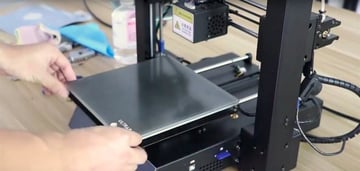
A step up from your everyday glass plate, the Anycubic Ultrabase has a special structure of nanoparticles applied to its surface, which cling to the print while hot, but easily release the object after it cools.
The Ultrabase is based on a piece of glass, and retains most of the relevant properties (stiffness, conductivity, and flatness). However, the bottoms of prints will not have the same smooth finish as seen while printing with just plain glass.
Another dissimilarity between the Ultrabase and everyday glass is that using an additional adhesive (like BuildTak, glue stick, or hairspray) is not recommended and can damage the special coating that makes the surface work. Of course, if the surface was previously damaged, this isn’t a worry and the plate is just as good as any other piece of glass.
One of the main problems with a built-in adhesive surface is that it can wear out over time and become damaged from improper use. Such occurrences necessitate the replacement of the entire build plate, something that can become costly for people who print more frequently.
BuildTak FlexPlate
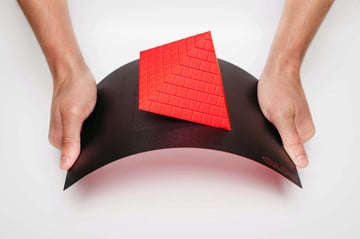
If a glass-based solution isn’t going to do the trick, perhaps you should look into something a little more flexible. Enter the BuildTak FlexPlate.
The FlexPlate is an interesting system consisting of magnets and a removable spring steel plate, which allows you to pop prints off of the bed by flexing the steel (hence the name). One of the perks of this system is that the build plate surface is removable and interchangeable, allowing for speedier printing in large production environments. This type of system was one of the bigger selling features of the legendary Prusa i3 MK3, and now you can add it to just about any printer.
The FlexPlate is intended to be used with BuildTak brand adhesive stickers or PEI, although one could feasibly use painter’s tape or other alternative brands of adhesive sticker. It’s not recommended to print directly on the spring steel with adhesives such as glue stick or hairspray.
The biggest issue with the FlexPlate is that it needs to be installed on a perfectly flat surface (like glass). Otherwise, the printer must have a mesh level system (and even then the surface needs to be flat). Without either of these, your prints likely won’t stick very well to the bed, as it will warp to fit the shape of the surface underneath.
Easy-Peelzy
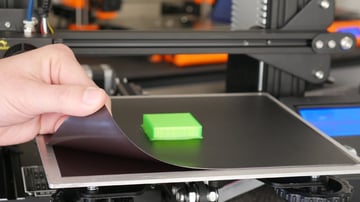
A similar system to the FlexPlate, the Easy-Peelzy is another option for a flexible, removable build plate.
Characterized by a special flexible and magnetic sheet, the Easy-Peelzy allows you to peel the build surface off of its magnetic base, and then peel it again, this time from the bottom of your prints. The appeal of such a system is that it’s very child-friendly. It requires no tools to remove the prints, and there’s no spring steel or potentially sharp edges to deal with.
The flexible sheet has a built-in adhesive surface similar to BuildTak, and requires no additional adhesive surfaces for prints to stick. We’re unsure as to whether you can use painter’s tape on top of the sheet, but in all likelihood this is a bad idea and will damage the surface.
The Easy-Peelzy shares the problem of the FlexPlate in that it needs to be installed on a flat surface. It also shares a problem with the Ultrabase, because the built-in adhesive on the flexible sheet will wear out over time, and can become damaged from misuse or improper printing settings. Such damage means that the sheet will need to be replaced, something that becomes costly over time.
Polypropylene
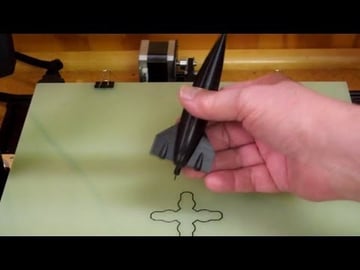
Polypropylene sheets are another fairly common build plate solution. These offer good adhesion directly to the surface, without additional adhesives, and are relatively cheap to purchase.
Polypropylene sheets are fairly durable, and with proper care won’t wear out as quickly as BuildTak or other build surface stickers. They provide a smooth, almost glass-like finish on the bottoms of prints. Users have noted that polypropylene acts similarly to the Ultrabase in that the prints will stick when hot and release fairly easily when cool. The surface is easily cleaned with alcohol or water, if necessary.
Polypropylene works well with most build surface stickers and other adhesive methods, although they’re not necessary.
Polypropylene sheets do have a few problems, however. Users have noted that the surface of the sheets is easily scratched and damaged. Also, the sheets can warp over time, and are not as reliably flat as glass.

